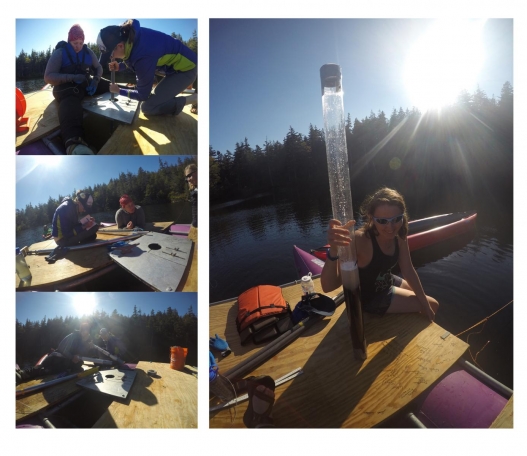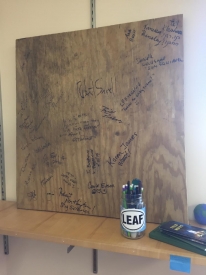
Paleoecology of Plant Communities around Treeline at Maine’s Oldest Pond
Paleoecology of Plant Communities around Treeline at Maine’s Oldest Pond
Acadia National Park 2017
Field Team Members: Caitlin McDonough MacKenzie, Jacquelyn Gill, Katherine Glover, Ben Burpee, Abe Miller-Rushing (Acadia National Park)
Research Location: Acadia National Park
September 26-30, 2017
Funding Support: David H. Smith Fellowship
Sargent Mountain Pond in Acadia National Park has the distinction of being Maine’s oldest pond. As the Laurentide ice sheet retreated, Sargent Mountain Pond emerged as the “first pond in Maine”; the rest of its limnological siblings were still under ice. Previous coring research at Sargent Mountain Pond has confirmed this and sediments in the basin are over 16,000 years old. Currently, Sargent Mountain Pond sits just below treeline on Sargent’s south ridge. I’m interested in the paleoecological history of alpine and subalpine plant communities in Maine, and the pollen record from such an old subalpine pond may shed light on past treeline dynamics.
We timed this fieldwork to coincide with a Sierra Club volunteer trip to Acadia National Park. During the last week in September a group of 9 Sierra Club volunteers and two leaders from Acadia National Park and Friends of Acadia lent their muscles and enthusiasm to projects across the park. On Tuesday, September 26, they joined the BEAST lab as we hauled coring equipment up to Sargent Mountain Pond. We carried in giant inflatable pontoons for a raft and two 4×8’ plywood decks: a major feat on a challenging trail. We hiked it all in, assembled the raft and inflated a kayak, and then launched our floating field site on to the pond.
From our raft, we extracted cores of sediment from the deepest basin of the pond — over 11 feet deep — using a piston corer. The piston corer allows us to push deep into the lake bottom and pull up 1 m of sediment in each drive. Over the course of three days we cored nearly 9 meters of sediment. These cores represent a journey through over 4 meters of organic material under Sargent Mountain Pond into the grey sands of a glacial landscape. We cored 4 meters deep twice: two overlapping records will give us a continuous chronicle of pollen through the last ~ 16,000 years. On Saturday, September 30, we were joined in the field by volunteers from Bar Harbor and CCI who came to help us carry out all the equipment. Without their generosity & strength, our raft and coring rods would still be out there in the field — this backcountry coring expedition was a whole community effort!
The pollen trapped in the pond’s sediments will help us to answer questions about the history of the subalpine plant communities around Sargent Mountain Pond. How dynamic is treeline on Acadia’s granite ridges? Have Mount Desert Island’s subalpine communities persisted here since the last ice age? How have these species responded to past climatic changes? With this paleoecological perspective, we hope to inform conservation managers and refine predictions on the vulnerability of these plant communities to anthropogenic climate change today.
- Acadia National Park Expedition 2017
- Acadia National Park Expedition 2017
Acknowledgements:
This work would not be possible without the generous support of the David H. Smith conservation research postdoctoral fellowship. We also thank LacCore for training during the Drilling and Coring Summer Institute and the pontoon raft rental.
Abe Miller-Rushing and Emma Albee at Acadia National Park provided support for our research permit, while Dianna McKeage coordinated the Sierra Club volunteers with Dana and Shane.
Many wonderful people volunteered with us — their signatures adorn the corner of the pontoon deck that we salvaged at the end of the trip — but we’d like to especially thank Karen James, who hauled equipment up and down, and publicized our call for volunteers to the Bar Harbor community.
The photos in this report were taken by Caitlin McDonough MacKenzie.



